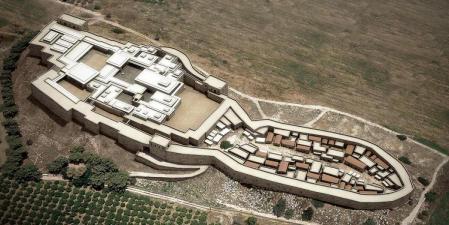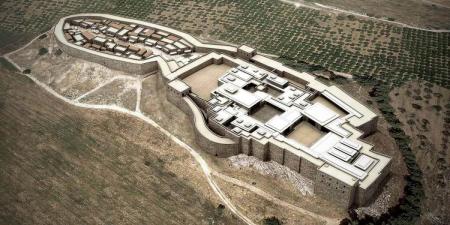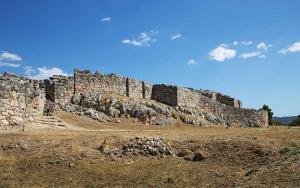Tiryns
TIRYNS - Distance from Ermioni: 81 kms/1.2 hours
Tiryns (Tiryntha) is a Mycenaean site 3.5 kms North of Nafplio and 7.5 kms from Argos. It was built on a rocky height and in ancient times was a hill fortress, with occupation dating back several thousand of years. It reached its height between 1400 and 1200 BC before the Trojan War. The most notable features of Tiryns were its palace, galleries, tunnels and especially its giant Cyclopean walls which gave the city its Homeric epithet of 'mighty walled Tiryns'. The walls of ancient Tiryns were said to be "Cyclopean" because they could only have been put in place by giants like the Cyclops, or a hero like Heracles. In ancient times, the city was linked to the myths surrounding Heracles, some sources gave it as his birthplace. Mythological sources suggest that Tiryns was fortified two generations before Mycenae, a fact that has been confirmed by recent archaeological excavations.
The city was founded by the mythical hero Tiryns, who was the son of Argos and grandson of Zeus. Inhabited from before the Bronze Age, right through the period of the Trojan War (1194-1184 BC) Tiryns flourished until the descent of the Dorians. The site went into decline at the end of the Mycenaean period, after 1180 BC, as it was destroyed first by an earthquake, then by fire and finally abandoned. Many years later, the city was re-populated and during the second Persian invasion of Greece, along with Mycenae, Tiryns sent 400 hoplite warriors to fight at the battle of Plataea in 479 BC, but in turn was destroyed by the city of Argos in 468 BC, transferring its people to Argos to increase its own population. However, Strabo stated that many Tirynthians moved to found the city of Halieis, modern Porto Heli. Tiryns was completely deserted by the time the Greek geographer and traveller Pausanias visited in the 2nd century.
The Tiryns site was excavated by Heinrich Schliemann in 1876, and continued by Dorpfeld in 1884, and is the subject of ongoing excavations. Many of the artifacts from Tiryns are now on display in the famous collection of Mycenaean antiquities at the National Archaeological Museum in Athens. Personal adornments like necklaces, gold rings, and decorative beads are presented, as well as pottery, seal stones, and fragments of clay tablets bearing the inscribed Linear B text, the earliest form of the Greek language.
As a visitor to Tiryns today, you will be impressed by the mythical Cyclopean walls, the galleries, as well as the palace with its main rooms and antechamber, which are all decorated with frescoes. There are great views of the surrounding countyside from the upper acropolis, including the Palamidi fortress of Nafplio and Larissa Castle of Argos. Tiryns was sited along the Greek Bronze Age highway from Mycenae and Argos to the North, to Epidavros and Troezen to the East, leading down to Hermione in the South-East. There is a Mycenaean tholos tomb, an acropolis fortress and three stone corbel bridges that one can see today along this ancient Mycenaean military highway, particulary near the present village of Arcadiko, at Kazarma (Ancient Lassa). The modern country road from Tiryns and Nafplio to Ligourio and Epidavros still runs alongside this ancient highway called the 'Mycenaean Route' which you can walk along today.
Tiryns occupies a notable place in Greek mythology, particularly in relation to the divine hero Heracles, Hera's Glory, who used the citadel as a base to carry out the first two of his legendary 'Twelve Labours', the slaying of the Nemean Lion and the 9-headed Lernaean Hydra, terrifying creatures that were terrorising the surrounding region. Heracles later used the lion’s impenetrable hide as his personal cloak. Heracles’ labours were imposed upon him by King Eurystheus of Tiryns, who assigned him these seemingly impossible tasks as punishment for the murder of Heracles' own wife and children in a fit of madness caused by the goddess Hera.


The artistic images above show 'mighty walled Tiryns' with the Royal palace complex on the Southern (Nafplio) side of the citadel.
According to a much later tradition, the city was originally founded by Proetus, who captured the site from his twin brother, Acrisius, the king of neighboring Argos. With the help of seven gigantic cyclopes from Lycia (southwest Asia Minor), Proteus occupied the outcrop and erected its famous walls. Through Proetus and Acrisius, Tiryns is also linked to the gorgon-slayer Perseus, Acrisius’ grandson, who went on to become the first king of Mycenae, thus placing the founding of Tiryns two generations earlier than its bigger and more famous sister-site to the north. From the 7th century BC until its destruction by the Argives, Tiryns had become an important cult centre for the worship of Hera, Athena and Heracles. Nearby tholos tombs indicate the presence of a royal cemetery.
 The decline of the heroic Mycenaean civilization during the mid-12th century BC, likely due to a combination of factors including environmental/climate changes, internal strife (following the Trojan War) and external invasions (by the migrating Dorians and the mysterious Sea Peoples) marked the end of Tiryns’ historic prominence. Nevertheless, even in terminal decline, the ancient citadel and its adjacent settlement remained inhabited until the 5th century BC, when it was destroyed by the neighbouring city of Argos in 468 BC in its bid to assert total, regional control. Tiryns finally became a Hellenistic fortress.
The decline of the heroic Mycenaean civilization during the mid-12th century BC, likely due to a combination of factors including environmental/climate changes, internal strife (following the Trojan War) and external invasions (by the migrating Dorians and the mysterious Sea Peoples) marked the end of Tiryns’ historic prominence. Nevertheless, even in terminal decline, the ancient citadel and its adjacent settlement remained inhabited until the 5th century BC, when it was destroyed by the neighbouring city of Argos in 468 BC in its bid to assert total, regional control. Tiryns finally became a Hellenistic fortress.
How to get from Ermioni to Tiryns:
Travel to Nafplio first, then turn right at the crossroad junction and follow the main road to Argos. Tiryns is situated about 3.5kms along, on the right side of this main road. The car-park, gift shop and entrance to the site are located at the far Northern side of the citadel. The site is open daily, apart from public holidays, from 08:00 - 15:00 during the Winter, and 08:00 - 20:00 May to August. Admission: 4 Euros. Tel: +30 27520 22657
If you are driving directly to Tiryns, there is a new road that eliminates the heavy traffic and chaos at the crossroads junction in the centre of Nafplio. Before you reach the busy junction, turn right at the traffic lights and continue straight on for approximately 400 metres, until you turn right again at the second set of traffic lights. This brings you onto the main road towards Tiryns and Argos.